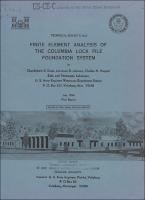Please use this identifier to cite or link to this item:
https://hdl.handle.net/11681/20582Full metadata record
| DC Field | Value | Language |
|---|---|---|
| dc.contributor | United States. Army. Corps of Engineers. Vicksburg District | - |
| dc.contributor.author | Desai, C. S. (Chandrakant S.), 1936- | - |
| dc.contributor.author | Johnson, Lawrence D. | - |
| dc.contributor.author | Hargett, Charles M. | - |
| dc.date.accessioned | 2017-01-11T18:50:21Z | - |
| dc.date.available | 2017-01-11T18:50:21Z | - |
| dc.date.issued | 1974-07 | - |
| dc.identifier.uri | http://hdl.handle.net/11681/20582 | - |
| dc.description | Technical Report | - |
| dc.description | Abstract: The Columbia Lock was designed as a gravity-type structure in which the load is transferred essentially through the foundation piles. Results obtained using Hrennikoff's method did not agree closely with observed field data in terms of the distribution of loads in the piles. The finite element (FE) method was therefore used to predict the behavior of the lock structure. As an approximation and to avoid undue amounts of manpower and computer efforts, the three-dimensional system was idealized as a structurally equivalent two-dimensional plane strain system. The FE method simulated major steps of construction including the in situ stress condition, dewatering, excavation, construction of piles and lock, backfilling, filling the lock with water, and development of uplift pressures. Nonlinear behavior of soils and of interfaces between the lock and surrounding soils and between the piles and the foundation soils was introduced into the analysis. The distribution of load in piles in the FE analysis showed improved agreement with field data in comparison with the agreement shown by Hrennikoff's method. The FE computations verified the trend shown by the observed field data that the piles on the backfill side carried an increased share of the applied load. | - |
| dc.publisher | Soils and Pavements Laboratory (U.S.) | - |
| dc.publisher | Engineer Research and Development Center (U.S.) | - |
| dc.relation | http://acwc.sdp.sirsi.net/client/en_US/search/asset/1045428 | - |
| dc.rights | Approved for public release; distribution is unlimited. | - |
| dc.source | This Digital Resource was created from scans of the Print Resource | - |
| dc.subject | Columbia Lock | - |
| dc.subject | Columbia Lock and Dam | - |
| dc.subject | Ouachita River | - |
| dc.subject | Louisiana | - |
| dc.subject | Load distribution | - |
| dc.subject | Settlement (structural) | - |
| dc.subject | Computer applications | - |
| dc.subject | Locks (waterways) | - |
| dc.subject | U-frame locks | - |
| dc.subject | Finite element method | - |
| dc.subject | Pile foundations | - |
| dc.subject | Foundations | - |
| dc.subject | Pile groups | - |
| dc.subject | Piling | - |
| dc.subject | Soil-structure interaction | - |
| dc.subject | Soil mechanics | - |
| dc.title | Finite element analysis of the Columbia Lock pile foundation system | - |
| dc.type | Report | en_US |
| Appears in Collections: | Technical Report | |
Files in This Item:
| File | Description | Size | Format | |
|---|---|---|---|---|
| TR-S-74-6.pdf | 4.64 MB | Adobe PDF |  View/Open |